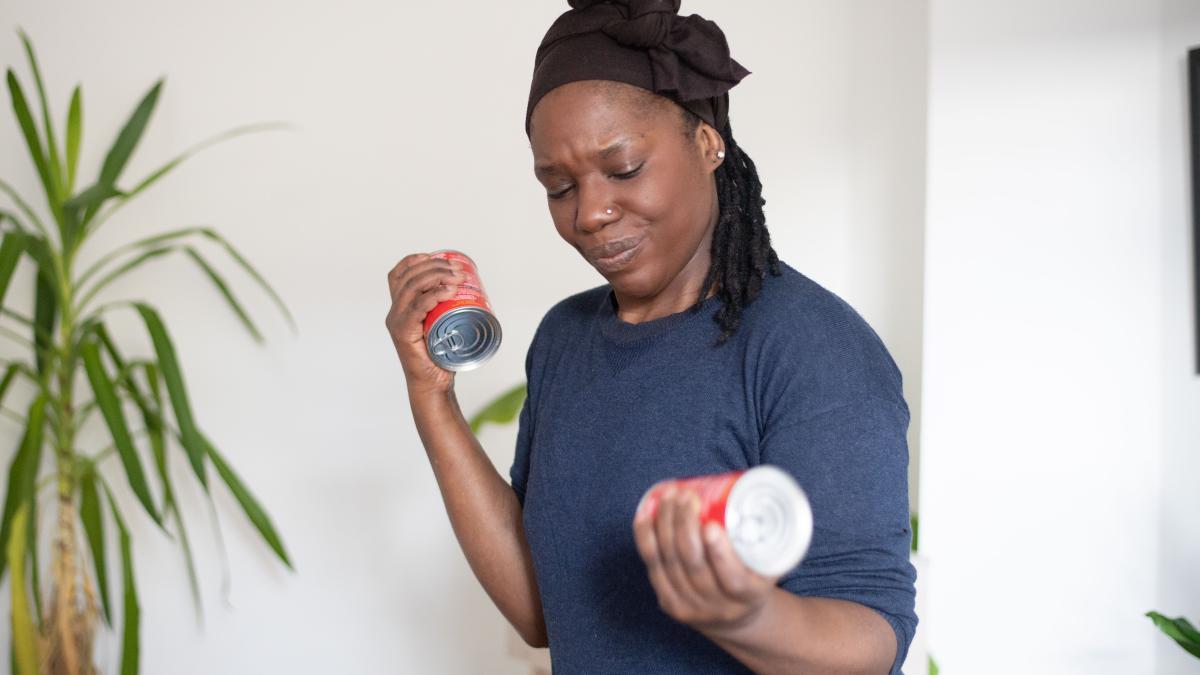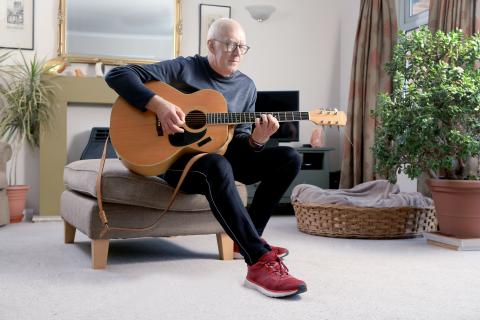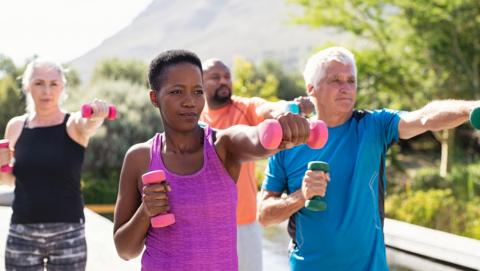If you are living with a long-term health condition, read on for some top tips on how to incorporate regular activity and strengthening into your life

Starting strengthening activity can be daunting, especially if you haven’t done much before and you are managing a health condition.
However, everyone can get stronger their way, no matter their age or physical condition. It’s completely free, and something we all have the power to start doing more of at any point in our lives.
Getting stronger after a stroke
Fatigue is very common after stroke and some activities may feel like doing a gym workout. However, regular activity and strength training are essential to enable recovery and your overall wellbeing.
Physical activity battles fatigue, anxiety and depression. It also protects the heart, lungs and bones. Set little, achievable goals, like walking daily. Consider investing in a fitness tracker to monitor your steps.
NHS England recommends 150 minutes of exercise per week. You can break it down to 30 minutes five-times a week. Or break it down to 15 x 10 minute sessions throughout the week. It’s important to start and finish the activity gradually, so you warm up and cool down. This helps your heart and lungs to build up and then wind down safely.
Small daily changes in your routine helps with rehab and recovery. Standing up correctly and using your affected limbs can have real impact. Doing your exercises once-a-day is great and helps with mood and achievement. Chores including washing up and vacuuming, as well as reaching to take objects in and out of cupboards also help aid recovery. No matter how small, it all adds up.
Walking is critical to strengthening and is the opposite of sedentary. It keeps your muscles active and strong. Try to walk at least a few minutes each hour and if you’re feeling up to it, challenge yourself even further by going up or downhill.
Completing exercises little and often during the day can help. A simple task like boiling a kettle can ring an exercise bell in your mind. The average person boils the kettle four times a day. In the time it takes to boil, you could do five to 10 squats and when you get stronger incorporate three or four sets at a time. When you’re brushing your teeth you can try to do 10 heel raises. As your calves get stronger, increase the sets.
Keeping all your joints moving and muscles active is important. If you’re sitting in a wheelchair most of the day, small movements like bending or straightening your knees, or marching your legs up and down can be vital to keep those joints from becoming stiff and painful.
Regular daily stretching routines are beneficial helping to keep your muscles relaxed and joints mobile. It helps with getting dressed and for reaching objects more easily.
Having good posture is vital for arms and legs to work efficiently. After stroke it’s harder. Improving core strength is paramount. Start simply by sitting in a chair with your chest tall and shoulder blades pulled back. Then, try to tighten your abdominal muscles to sit in this position for as long as possible. Be careful not to hold your breath. Start with two to three minutes. Maintaining this posture while driving or walking can produce excellent results.
If you have an upper limb impairment, consider taking up a hobby to help recovery. Activities like knitting, jigsaw puzzles, building models or even playing fun games like Scrabble, Connect 4, and Dominos with children or other adults will help with awareness in hand-eye coordination.
Find out about accessing your local pool. Walking in water, swimming or aqua aerobics are tremendous cardiovascular exercise. They help your muscles, while the water lessens resistance on the joints. Consider incorporating water weights as you progress and get stronger. There’s also buoyancy belts, which simulate water jogging, and other items like aqua noodles to help you keep afloat.
After stroke weakness in limbs is common. So muscle strengthening exercises such as; wall squats, lunges, planks, glute bridges and wall push-ups are beneficial. They build strength in your legs, core, arms and glutes. You can do these at home, building repetitions over time to improve muscle memory. When you’re ready to challenge yourself further you can add weights.
Be patient and kind with yourself. It’s okay to be frustrated when you can't do things you used to. Recovery takes time and you can develop new strategies to do things differently. There is no right or wrong when it comes to stroke. Every person is different, no matter who they are, no two strokes are the same.
Don't give up. Try to stay positive. Think about your successes and how far you've come. Set yourself realistic goals and focus the victories, no matter how small.
Make any work-out your body can handle a goal. However, taking time out to recharge your mind is just as important as building your muscles. Activities such as mindfulness and meditation are proven to help.
Getting stronger with cancer
A physically active lifestyle both during and after cancer treatment is proven to help both physical and mental wellbeing.
Physical activity battles fatigue, anxiety and depression. It also protects the heart, lungs and bones. Set little, achievable goals, like walking daily. Consider investing in a fitness tracker to monitor your steps.
NHS England recommends 150 minutes of exercise per week. You can break it down to 30 minutes five-times a week. Or break it down to 15 x 10 minute sessions throughout the week. It’s important to start and finish the activity gradually, so you warm up and cool down. This helps your heart and lungs to build up and then wind down safely.
Resistance training is one of the most important exercises during and after cancer treatment. It builds strength, bone density and energy levels. You can use weights and bands and make use of what’s available in and around your home. Get started by trying a simple sit-to-stand exercise. Sit on a chair and stand up five to ten times in one go if you can. Try the sit-to-stand exercise several times a day, if achievable. If you have stair access inside your home try going up and down as many times as possible. You could also attempt to carry shopping bags from the car into your house.
Aerobic training is often seen as doing things like running, cycling and swimming. Often with cancer, fatigue and weakness may make these activities impossible. Daily chores like vacuuming, sweeping, mopping and doing the laundry count as activities. Things like bathing, dressing, or cooking, use muscle strength too and can be the ideal starting point, if strength training is not practicable.
Completing exercises little and often during the day can help. A simple task like boiling a kettle can ring an exercise bell in your mind. The average person boils the kettle four times a day. In the time it takes to boil, you could do five to 10 squats and when you get stronger incorporate three or four sets at a time. When you’re brushing your teeth you can try to do 10 heel raises. As your calves get stronger, increase the sets.
Improving core strength is key to preventing injury and may protect your body. You use core strength in almost everything you do. If your core is not strong your body uses other muscles to compensate which can drain energy. To strengthen your core, start simply by sitting in a chair with your chest tall and shoulder blades pulled back. Then, try to tighten your abdominal muscles to sit in this position for as long as possible. Be careful not to hold your breath. Start with two to three minutes. Maintaining this posture while driving or walking can produce good results too.
Find a family member or friend to support you with the activities with you enjoy. Remember, you are not alone, millions of people struggle to be active after a cancer diagnosis.
Choose an activity you like and have a go at some you might not have tried. Starting is difficult but once you’ve tried, it will become easier and you will be happy you did.
Avoid being sedentary if possible but accept there will be days where your body is unable to because of your treatment. It’s fine to accept the things you can’t change. Listen to your body and pace your activity based on the demands of your day and the energy you have. Try to eat a nutritious diet, when possible, to boost energy levels.
Make any work-out your body can handle a goal. However, taking time out to recharge your mind is just as important as building your muscles. Activities such as mindfulness and meditation are proven to help.
Getting stronger with heart disease
Strengthening activity helps patients with coronary heart disease. It may reduce the risk of having further problems and help you recover from a heart attack or surgery.
Physical activity battles fatigue, anxiety and depression. It also protects the heart, lungs and bones. Set little, achievable goals, like walking daily. Consider investing in a fitness tracker to monitor your steps.
NHS England recommends 150 minutes of exercise per week. You can break it down to 30 minutes five-times a week. Or break it down to 15 x 10 minute sessions throughout the week. It’s important to start and finish the activity gradually, so you warm up and cool down. This helps your heart and lungs to build up and then wind down safely.
Activities using the whole body such as brisk walking, running, and swimming, cycling, playing tennis and skipping are good. Moderate intensity is best. It increases breathing, so it’s faster and deeper and might whip up a sweat.
Wall squats, lunges, planks, glute bridges and wall push to build strength in your legs, core, arms and glutes are excellent exercises. You can do these at home without the need for equipment. You should build the amount of repetitions over time, attempting to make them harder each time. Then try incorporating weights to challenge yourself further, when you’re ready.
Completing exercises little and often during the day can help. A simple task like boiling a kettle can ring an exercise bell in your mind. The average person boils the kettle four times a day. In the time it takes to boil, you could do five to 10 squats and when you get stronger and incorporate three or four sets at a time. When you’re brushing your teeth you can try to do 10 heel raises. As your calves get stronger, increase the sets.
Try resistance exercise twice a week. It helps to improve muscle strength and circulation. Start with body weight exercises mentioned in the earlier paragraphs. If you find you can do them with ease, try to add weights. The weight you use shouldn't be too heavy. Try 10 reps at first then increase gradually.
Find out about accessing your local pool. Walking in water, swimming or aqua aerobics is tremendous cardiovascular exercise. They help your muscles, while the water lessens resistance on the joints. Consider incorporating water weights as you progress and get stronger. There’s also buoyancy belts, which simulate water jogging, and other items like aqua noodles to help you keep afloat.
If you have stair access inside your home try going up and down as many times as possible to strengthen your legs. If you don’t have stairs try marching on the spot, making an effort to lift your knee to waist height.
Make any work-out your body can handle a goal. However, taking time out to recharge your mind is just as important as building your muscles. Activities such as mindfulness and meditation are proven to help.
Getting stronger with multiple sclerosis
Regular, moderate exercise is an important part of maintaining good health and wellbeing for people with multiple sclerosis. Evidence proves keeping active and progressive strength training helps with many MS symptoms.
Physical activity battles fatigue, anxiety and depression. It also protects the heart, lungs and bones. Set little, achievable goals, like walking daily. Consider investing in a fitness tracker to monitor your steps.
NHS England recommends 150 minutes of exercise per week. You can break it down to 30 minutes five-times a week. Or break it down to 15 x 10 minute sessions throughout the week. It’s important to start and finish the activity gradually, so you warm up and cool down. This helps your heart and lungs to build up and then wind down safely.
Everyone’s MS is different and there’s no one-size-fits all fix to become stronger with the condition. Adopt flexible thinking and pace yourself with activities. Relapsing-remitting MS is changeable. No one day will necessarily feel the same.
Try to complete exercises little and often during the day. A simple task like boiling a kettle can ring an exercise bell in your mind. The average person boils the kettle four times a day. In the time it takes to boil, you could do five to 10 squats. Or if you feel stronger, incorporate three or four sets at a time. When you’re brushing your teeth you can try to do 10 heel raises. If your calves feel stronger, increase the sets.
Keeping all your joints moving and muscles active is important. If you’re sitting in a wheelchair most of the day, small movements like bending or straightening your knees, or marching your legs up and down can be vital to keep those joints from becoming stiff and painful.
If symptoms affect your energy levels, consider doing light exercise to help build up your strength and stamina, like yoga, Pilates or stretching.
Studies have shown that resistance training in particular can improve strength over time for people with MS and can also increase cortical thickness in people with relapsing-remitting MS.
Find out about accessing your local pool. Walking in water, swimming or aqua aerobics are tremendous cardiovascular exercise. They help your muscles, while the water lessens resistance on the joints. Consider incorporating water weights if you feel stronger. There’s also buoyancy belts, which simulate water jogging, and other items like aqua noodles to help you keep afloat. These can all be adapted to a wide-range of MS symptoms from mild to moderate and severe.
Limb and muscle weakness may be a symptom of your MS. So wall squats, lunges, planks, glute bridges and wall push ups can be beneficial to build strength in your legs, core, arms and glutes. You can do these at home and increase the repetitions over time, even incorporating weights to challenge yourself further, when you are ready.
Ensure every time you stand up or walk around the motion and posture is performed to the best of your ability.
If you have stair access inside your home try going up and down as many times as possible to strengthen your legs. If you don’t have stairs try marching on the spot, making an effort to lift your knee to waist height.
Try not to compare yourself to others. Everyone with MS has different problems with different rates of disease progression. Focus on what you can do now and what you can do to improve.
Ensure you have a support group around you such as family, friends or a community group. Remember it is ok to ask for help if you need it.
Make any work-out your body can handle a goal. However, taking time out to recharge your mind is just as important as building your muscles. Activities such as mindfulness and meditation are proven to help.
Getting stronger with chronic pain
Chronic pain affects between 20-50% of the UK population. Most people are able to carry on with daily activities. For around seven percent of people, the pain makes life difficult to manage. If you’re really suffering, a pain management clinic referral from your GP will help. The good news is regular movement and strengthening can help to decrease inflammation, increase mobility, and decrease overall pain levels.
Physical activity battles fatigue, anxiety and depression. It also protects the heart, lungs and bones. Set little, achievable goals, like walking daily. Consider investing in a fitness tracker to monitor your steps.
NHS England recommends 150 minutes of exercise per week. You can break it down to 30 minutes five-times a week. Or break it down to 15 x 10 minute sessions throughout the week. It’s important to start and finish the activity gradually, so you warm up and cool down. This helps your heart and lungs to build up and then wind down safely.
It’s more helpful to start off little and often and gradually build up your stamina and fitness levels. When it comes to physical activity, variety is important, so that you’re not overworking a specific muscle group. Try a combination of strength exercises, cardiovascular activity, stretching and relaxation. Make sure you monitor your levels of pain during and after.
Building strength happens over time. It’s important because it helps to stabilise the joints and prevent future injuries. For people living with chronic pain, improving core strength is particularly important. It helps maintain good posture and balance. Choose a variety of strengthening activities that work the muscles of the abdomen, hips and back.
Consider incorporating resistance training into your week. It can help with chronic pain as it improves a person's ability to support bone and cartilage. Resistance training can decrease stiffness, which contributes to being in more pain over time.
The pain may or may not change with the exercise you choose. You should notice that you are able to do more without the pain stopping you or flaring up afterwards. It’s useful to notice how your strength and ability change and improves, rather than expecting the pain to reduce.
Being part of a community is important especially ones which encourage you to get out with others. There are many chronic pain groups in the local community and it may be helpful to connect with them.
Strengthening activities don’t require you to join to a gym or even lift a weight. Think about other forms of activity you enjoy, like gardening and walking. Walking 30 minutes three to five times per week can help increase strength, endurance, and heart health.
Completing exercises little and often during the day can help. A simple task like boiling a kettle can ring an exercise bell in your mind. The average person boils the kettle four times a day. In the time it takes to boil, you could do five to 10 squats and when you get stronger incorporate three or four sets at a time. When you’re brushing your teeth you can try to do 10 heel raises. As your calves get stronger, increase the sets.
Find out about accessing your local pool. Walking in water, swimming or aqua aerobics are tremendous cardiovascular exercise. They help your muscles, while the water lessens resistance on the joints. Consider incorporating water weights as you progress and get stronger. There’s also buoyancy belts, which simulate water jogging, and other items like aqua noodles to help you keep afloat.
Flare-ups in pain are a normal part of living with chronic pain. The usual symptoms you experience may change from day-to-day. There will be times when they increase. It is helpful to plan for these periods of flare-up to manage them and keep doing things you enjoy and are important to you.
Make any work-out your body can handle a goal. However, taking time out to recharge your mind is just as important as building your muscles. Activities such as mindfulness and meditation are proven to help.







































